2007 SUBARU TRIBECA battery
[x] Cancel search: batteryPage 233 of 377
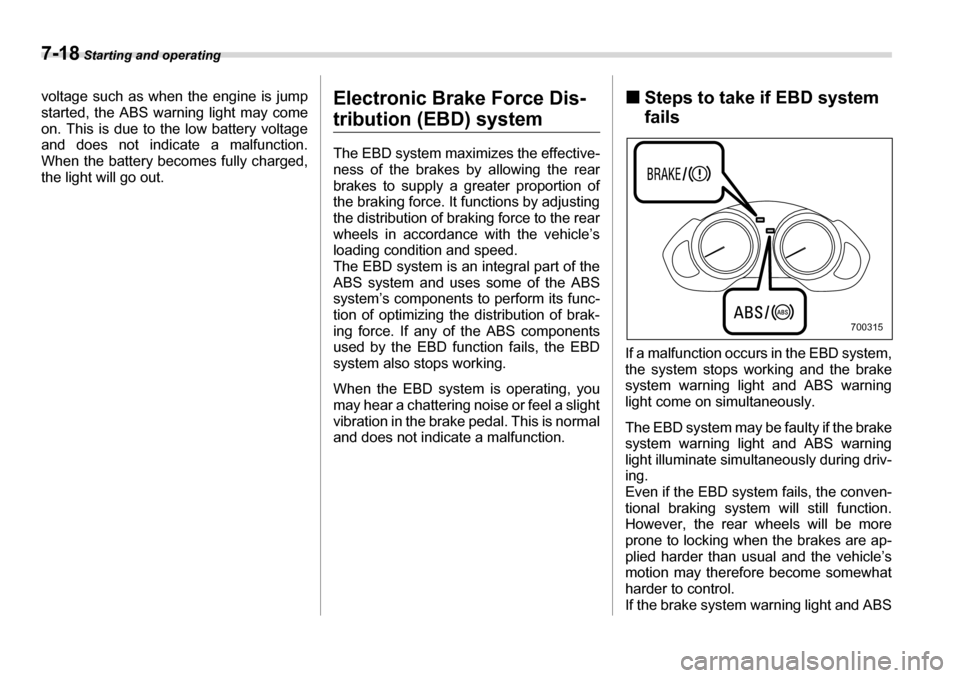
7-18 Starting and operating
voltage such as when the engine is jump started, the ABS warning light may come
on. This is due to the low battery voltage
and does not indicate a malfunction.
When the battery becomes fully charged,
the light will go out. Electronic Brake Force Dis-
tribution (EBD) system
The EBD system maximizes the effective-
ness of the brakes by allowing the rear
brakes to supply a greater proportion of
the braking force. It functions by adjusting
the distribution of braking force to the rear
wheels in accordance with the vehicle’s
loading condition and speed.
The EBD system is an integral part of the
ABS system and uses some of the ABS
system’s components to perform its func-
tion of optimizing the distribution of brak- ing force. If any of the ABS components
used by the EBD function fails, the EBD
system also stops working.
When the EBD system is operating, you
may hear a chattering noise or feel a slight
vibration in the brake pedal. This is normal
and does not indicate a malfunction.�„
Steps to take if EBD system
fails
If a malfunction occurs in the EBD system,
the system stops working and the brake
system warning light and ABS warning
light come on simultaneously.
The EBD system may be faulty if the brake
system warning light and ABS warning
light illuminate simultaneously during driv-
ing.
Even if the EBD system fails, the conven-
tional braking system will still function.
However, the rear wheels will be more
prone to locking when the brakes are ap-
plied harder than usual and the vehicle’s
motion may therefore become somewhat
harder to control. If the brake system warning light and ABS
700315
Page 252 of 377

Driving tips 8-7
– CONTINUED –
underbody. Clear off any such matter from
the underbody. If the vehicle is used with
these materials trapped or adhering to the
underbody, a mechanical breakdown or
fire could occur. �y
Secure all cargo carried inside the vehi-
cle and make certain that it is not piled
higher than the seatbacks. During sudden
stops or jolts, unsecured cargo could be
thrown around in the vehicle and cause in-
jury. Do not pile heavy loads on the roof.
Those loads raise the vehicle’s center of
gravity and make it more prone to tip over. �y If you must rock the vehicle to free it
from sand or mud, depress the accelera-
tor pedal slightly and move the selector le-
ver back and forth between “D” and “R” re-
peatedly. Do not race the engine. For the
best possible traction, avoid spinning the
wheels when trying to free the vehicle. �y When the road surface is extremely
slippery, you can obtain better traction by
starting the vehicle with the transmission
in 2nd than 1st. �y Never equip your vehicle with tires larg-
er than those specified in this manual. �y Wash the vehicle’s underbody after off-
road driving. Suspension components are
particularly prone to dirt buildup, so they
need to be washed thoroughly. �y Frequent driving of an AWD vehicle un-
der hard-driving conditions such as rough roads or off roads will necessitate more
frequent replacement of engine oil, brake
fluid and transmission oil than that speci-
fied in the maintenance schedule de-
scribed in the “Warranty and Maintenance Booklet”.
Remember that damage done to your
SUBARU while operating it off-road and
not using common sense precautions
such as those listed above is not eligible for warranty coverage.
Winter driving �„
Operation during cold weath- er
Carry some emergency equipment, such
as tire chains, a window scraper, a bag of
sand, flares, a small shovel, and jumper cables.
Check the battery and cables. Cold tem-
peratures reduce battery capacity. The
battery must be in good condition to pro-
vide enough power for cold winter starts.
Use an engine oil of proper grade and vis-
cosity for cold weather. Heavy summer oil
will cause harder starting.
Keep the door locks from freezing by
800201
Page 282 of 377

In case of emergency 9-11
– CONTINUED –
Jump starting
If the low tire pressure warning light
comes on while driving, never brake
suddenly and keep driving straight
ahead while gradually reducing
speed. Then slowly pull off the road
to a safe place. Otherwise an acci-
dent involving serious vehicle dam-
age and serious personal injury
could occur.
Check the pressure for all four tires
and adjust the pressure to the COLD
tire pressure shown on the vehicle
placard on the door pillar on the
driver’s side. If this light still comes
on while driving after adjusting the
tire pressure, a tire may have signif-
icant damage and a fast leak that
causes the tire to lose air rapidly. If
you have a flat tire, replace it with a
spare tire as soon as possible.
When a spare tire is mounted or a
wheel rim is replaced without the
original pressure sensor/transmitter
being transferred, the low tire pres-
sure warning light will flash. This in-
dicates the TPMS is unable to moni-
tor all four road wheels. Contact
your SUBARU dealer as soon as
possible for tire and sensor replace-
ment and/or system resetting.
Do not inject any tire liquid or aero-
sol tire sealant into the tires, as this
may cause a malfunction of the tire
pressure sensors.
If the light flashes, promptly contact
a SUBARU dealer to have the sys-
tem inspected.
�yBattery fluid is SULFURIC ACID.
Do not let it come in contact with
the eyes, skin, clothing or the ve- hicle.
If battery fluid gets on you, thor-
oughly flush the exposed area
with water immediately. Get medi-
cal help if the fluid has entered
your eyes.
If battery fluid is accidentally
swallowed, immediately drink a
large amount of milk or water, and
obtain immediate medical help.
Keep everyone including children
away from the battery.
�yThe gas generated by a battery ex-
plodes if a flame or spark is
brought near it. Do not smoke or
light a match while jump starting.
�yNever attempt jump starting if the
discharged battery is frozen. It
could cause the battery to burst or
explode.
Page 283 of 377
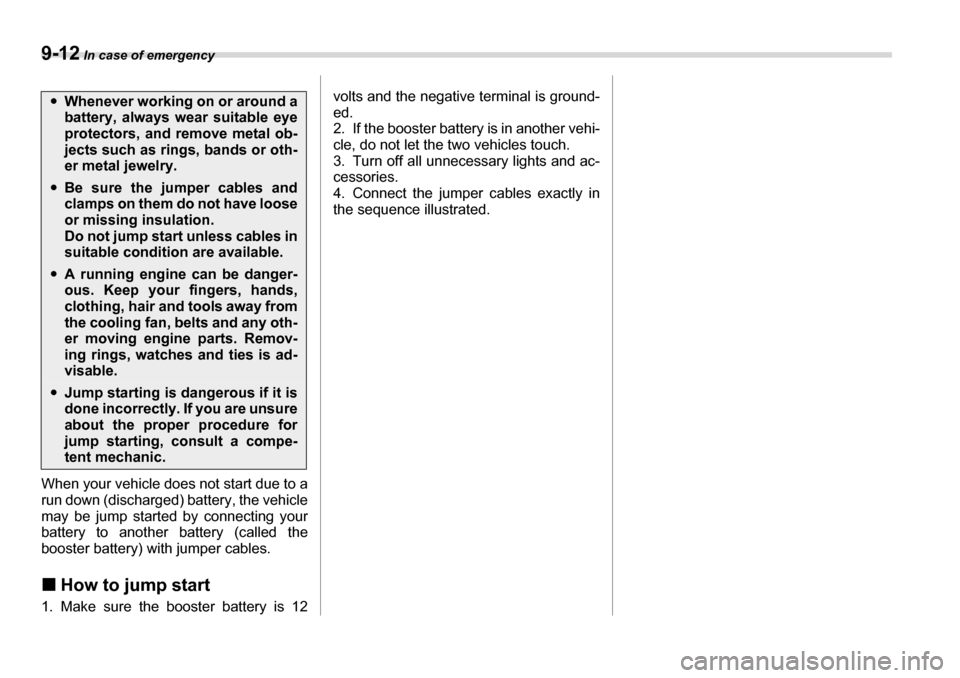
9-12 In case of emergency
When your vehicle does not start due to a
run down (discharged) battery, the vehicle
may be jump started by connecting your
battery to another battery (called the
booster battery) with jumper cables. �„How to jump start
1. Make sure the booster battery is 12 volts and the negative terminal is ground- ed.
2. If the booster battery is in another vehi-
cle, do not let the two vehicles touch.
3. Turn off all unnecessary lights and ac-
cessories.
4. Connect the jumper cables exactly in
the sequence illustrated.
�y
Whenever working on or around a
battery, always wear suitable eye
protectors, and remove metal ob-
jects such as rings, bands or oth-
er metal jewelry.
�yBe sure the jumper cables and
clamps on them do not have loose
or missing insulation.
Do not jump start unless cables in
suitable condition are available.
�yA running engine can be danger-
ous. Keep your fingers, hands,
clothing, hair and tools away from
the cooling fan, belts and any oth-
er moving engine parts. Remov-
ing rings, watches and ties is ad-
visable.
�yJump starting is dangerous if it is
done incorrectly. If you are unsure
about the proper procedure for
jump starting, consult a compe-
tent mechanic.
Page 284 of 377

In case of emergency 9-13
– CONTINUED –
(2)
(4)
(1) (3)
900216
1) Connect one jumper cable to the pos-
itive (+) terminal on the discharged bat-
tery.
2) Connect the other end of the jumper
cable to the positive (+) terminal of the
booster battery.
3) Connect one end of the other cable to
the negative (–) terminal of the booster battery.
4) Connect the other end of the cable to
the strut mounting nut.
Make sure that the cables are not near
any moving parts and that the cable
clamps are not in contact with any other metal.
Page 285 of 377
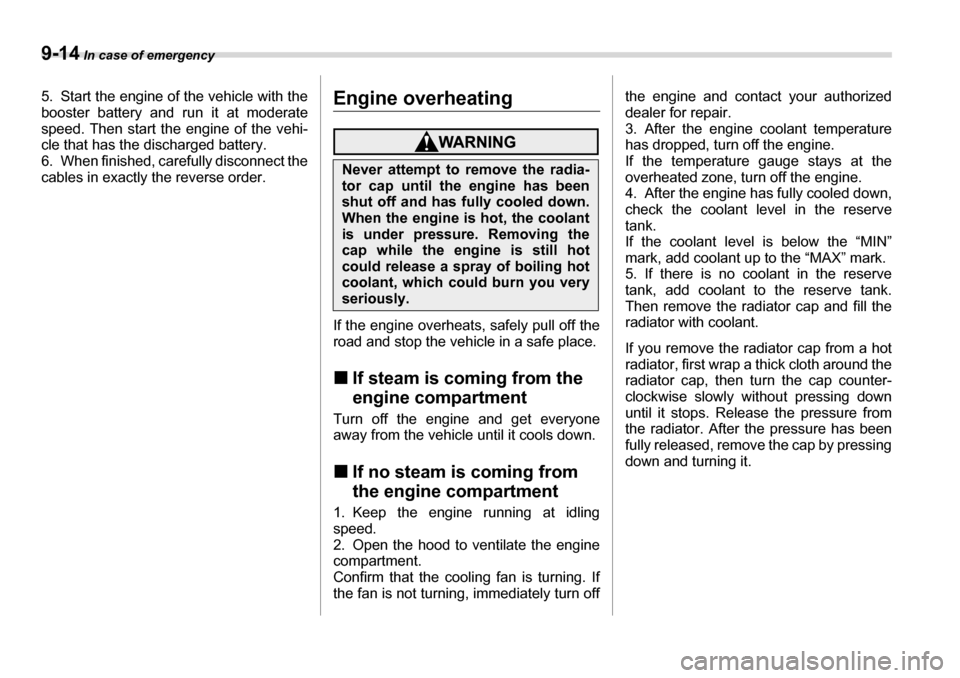
9-14 In case of emergency
5. Start the engine of the vehicle with the
booster battery and run it at moderate
speed. Then start the engine of the vehi-
cle that has the discharged battery.
6. When finished, carefully disconnect the
cables in exactly the reverse order.Engine overheating
If the engine overheats, safely pull off the
road and stop the vehicle in a safe place. �„If steam is coming from the
engine compartment
Turn off the engine and get everyone
away from the vehicle until it cools down. �„ If no steam is coming from
the engine compartment
1. Keep the engine running at idling
speed.
2. Open the hood to ventilate the engine compartment.
Confirm that the cooling fan is turning. If
the fan is not turning, immediately turn off the engine and contact your authorized
dealer for repair.
3. After the engine coolant temperature
has dropped, turn off the engine.
If the temperature gauge stays at the
overheated zone, turn off the engine.
4. After the engine has fully cooled down,
check the coolant level in the reserve
tank.
If the coolant level is below the “MIN”
mark, add coolant up to the “MAX” mark.
5. If there is no coolant in the reserve
tank, add coolant to the reserve tank.
Then remove the radiator cap and fill the
radiator with coolant.
If you remove the radiator cap from a hot
radiator, first wrap a thick cloth around the
radiator cap, then turn the cap counter-
clockwise slowly without pressing down
until it stops. Release the pressure from
the radiator. After the pressure has been
fully released, remove the cap by pressing
down and turning it.
Never attempt to remove the radia-
tor cap until the engine has been
shut off and has fully cooled down.
When the engine is hot, the coolant
is under pressure. Removing the
cap while the engine is still hot
could release a spray of boiling hot
coolant, which could burn you very
seriously.
Page 299 of 377
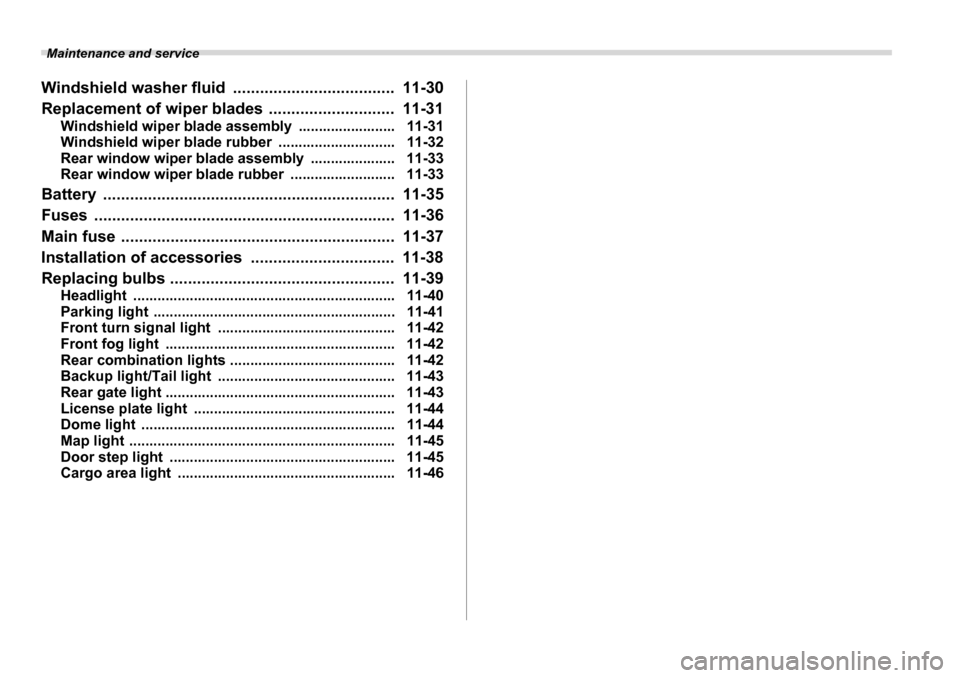
Maintenance and service
Windshield washer fluid .................................... 11-30
Replacement of wiper blades ............................ 11-31
Windshield wiper blade assembly ........................ 11-31
Windshield wiper blade rubber ............................. 11-32
Rear window wiper blade assembly ..................... 11-33
Rear window wiper blade rubber .......................... 11-33
Battery ................................................................. 11-35
Fuses ................................................................... 11-36
Main fuse ............................................................. 11-37
Installation of accessories ................................ 11-38
Replacing bulbs .................................................. 11-39 Headlight ................................................................. 11-40
Parking light ............................................................ 11-41
Front turn signal light ............................................ 11-42
Front fog light ......................................................... 11-42
Rear combination lights ......................................... 11-42
Backup light/Tail light ............................................ 11-43
Rear gate light ......................................................... 11-43
License plate light .................................................. 11-44
Dome light ............................................................... 11-44
Map light .................................................................. 11-45
Door step light ........................................................ 11-45
Cargo area light ...................................................... 11-46
Page 300 of 377
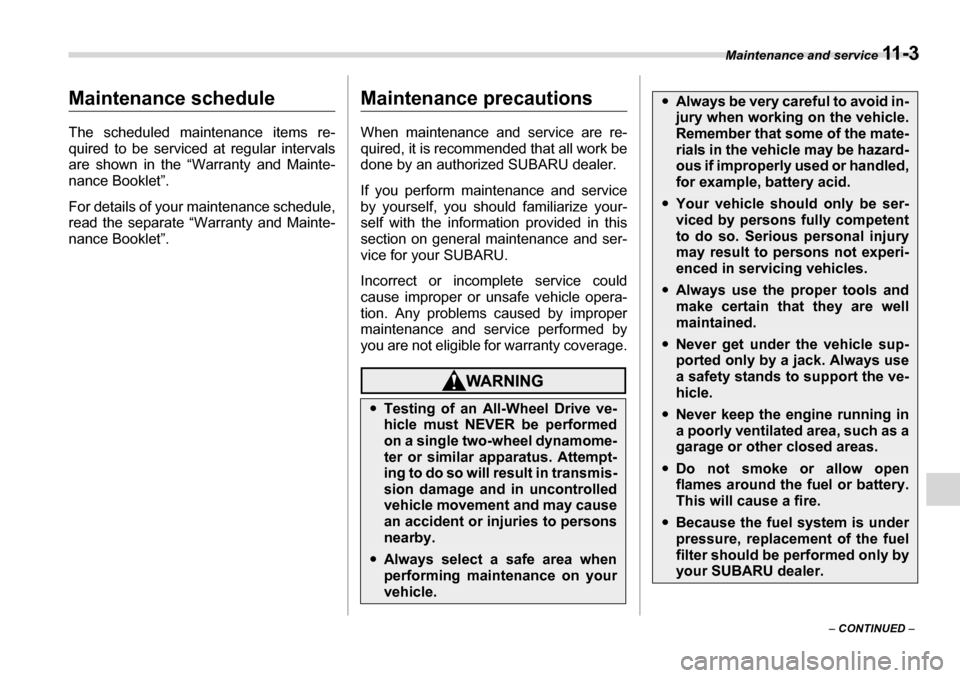
Maintenance and service 11 - 3
– CONTINUED –
Maintenance and serviceMaintenance schedule
The scheduled maintenance items re-
quired to be serviced at regular intervals
are shown in the “Warranty and Mainte-
nance Booklet”.
For details of your maintenance schedule,
read the separate “Warranty and Mainte-
nance Booklet”.Maintenance precautions
When maintenance and service are re-
quired, it is recommended that all work be
done by an authorized SUBARU dealer.
If you perform maintenance and service
by yourself, you should familiarize your-
self with the information provided in this
section on general maintenance and ser-
vice for your SUBARU.
Incorrect or incomplete service could
cause improper or unsafe vehicle opera-
tion. Any problems caused by improper
maintenance and service performed by
you are not eligible for warranty coverage.
�yTesting of an All-Wheel Drive ve-
hicle must NEVER be performed
on a single two-wheel dynamome- ter or similar apparatus. Attempt-
ing to do so will result in transmis-
sion damage and in uncontrolled
vehicle movement and may cause
an accident or injuries to persons
nearby.
�yAlways select a safe area when
performing maintenance on yourvehicle.
�yAlways be very careful to avoid in-
jury when working on the vehicle.
Remember that some of the mate-
rials in the vehicle may be hazard-
ous if improperly used or handled,
for example, battery acid.
�yYour vehicle should only be ser-
viced by persons fully competent
to do so. Serious personal injury
may result to persons not experi-
enced in servicing vehicles.
�yAlways use the proper tools and
make certain that they are well
maintained.
�yNever get under the vehicle sup-
ported only by a jack. Always use
a safety stands to support the ve- hicle.
�yNever keep the engine running in
a poorly ventilated area, such as a
garage or other closed areas.
�yDo not smoke or allow open
flames around the fuel or battery.
This will cause a fire.
�yBecause the fuel system is under
pressure, replacement of the fuel
filter should be performed only by
your SUBARU dealer.